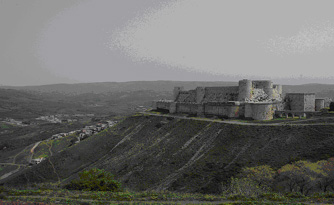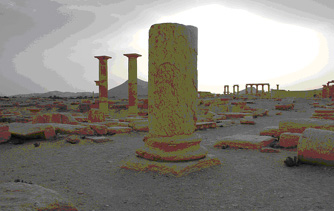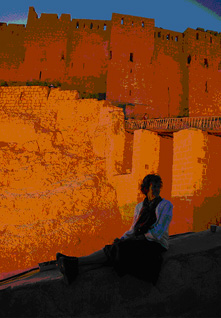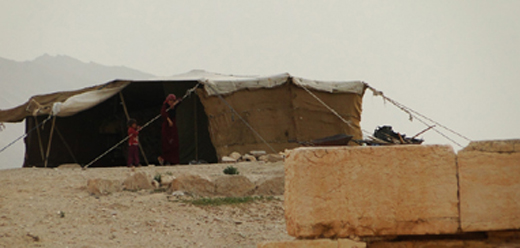![]()
2011 SYRIA - JORDAN TOUR
April 16, 2011 Saturday
Day 04
Homs, Krak de Chevalier, Palmyra
Submitted by Mark Lammers
Pictures - Meli
Click here for Day 5 in Syria - Maloula and Damascus
Table of Content Syria tour Itinerary
Home page
Syria 2011 group journal


Mark's Palmyra

Marilyn enjoying moon rise over
Palmyra
By Mark

Passing by Homs it was very tempting to try to go in the town again.
This morning every thing was quiet. there was no sign of last nights
hastle here.
We get an early morning wakeup call from our “Motel 6” by the highway
in Ma’arat An-Nu’man. At breakfast MK uses hilarious charades to
communicate that we need hot water for our Starbucks instant coffee (Via).
We head south hoping that the roads are once again open and that the
trouble from yesterday has dissipated from Hama and Homs. The roads are
indeed open and we are able to get in to Hama to see the waterwheels,
although they are not operating so we can’t hear the moaning sound they
make. We can only imagine it. No signs of yesterday’s troubles on the
street. All is quiet. 

Ayman could not resist the fresh sobiet.
He got a big box for the bus.

The next stop was Krak de Chevalier



The word krak comes from the
Syriac word karak meaning fortress. The huge castle is actually two structures. The original fortification here was built by the Emir of Homs in around 1031 to control the mountain pass between the coast and the interior. The Emir garrisoned Kurdish soldiers here. In 1109 it was captured by Tancred of Antioch and held by crusaders until 1271. The existing structure today is two buildings, an exterior fortress and an interior castle. The crusaders probably raised the original fortress and re-built it. They built the interior castle and added on to it over the 162 years that crusaders occupied this sit. In its day the Krak would have garrisoned 2000 soldiers, about 100 of which were actual knights. They stored enough food to last for 400 days.In 1271 the Mameluke Sultan Baibars lay siege to the castle with an Egyptian army. The knights of the Krak received a letter saying that reinforcements were not coming and that they should surrender. That was the last time that the krak would be used by infidels until the French used it when they assumed power and set up the French Mandate in 1920. I imagine the locals thought that the crusaders were back again…
Lunch at al Kalaa where our ragingly flamboyant server called Amron who amused us. He was a cross between Richard Simmons and Borat. “Breast or leg?” “Right or left?” “Good idea”

The drive to Palmyra is 3 hours. The landscape changes with the blink of an eye. One minute you see the lush Mediterranean vegetation – cypresses and fields of agriculture – and then it’s expansive sand as far as the eye can see. We expect to see TE Lawrence and his crew of Arabs swooping down on the bus. We see road signs for Bagdad -- we are not in Kansas anymore, Toto.
Palmyra is a beautiful oasis town whose golden limestone structures blend perfectly with the surrounding desert. The site was originally settled around the 2nd Millennium BC, but the city left today was built around the 2nd and 3rd centuries AD. The town’s raison d’etre was its water and its strategic trading location halfway between Antioch and the Tigris & Euphrates river valley. It flourished as Rome’s desire for exotic ‘goods’ increased – spices, silk, slaves, ebony. The city was ‘free’ and only nominally controlled by Rome.




Carole did not leave a corner un
inspected

under the architrave she was able to take the picture of the angel with a
fling horse
The city declined came when the Persian Sassanids took control of the Tigris & Euphrates valley, effectively cutting off trade with the East. The governor Udainat was killed fighting the Sassanids and his wife, Queen Zenobia, took control for her under-age son. She thought herself to be descended from Cleopatra. She attacked Homs, Antioch, Egypt and parts of Anatolia. In 1273 Arelian sacked the city and it never fully recovered. Captured by the Muslims in 643, it was bypassed by the main caravan trading routes. The Mongols lay waste to it in the 13th Century AD.

Palmyra was a hub on the silk road. the grand entrance to the straight road was magnificent. We were approaching the city as the sun was going down at a wonderful level . The light on the sand stones was very exciting for the photographers. There were no other tourists which also added to the magic of the location
We marched through the grand street and found our selves at the tiny theater.

The sanctuary Bel Temple is isolated inside a massive courtyard. This is the largest temple we have seen. The colonnaded street extends from the temple towards the mountains. The site is serene and calm, except for the vendors who pursue us endlessly on their motorcycles. The people of this area still depend on commerce and trade, obviously.


The Bedouins still live in Palmyra.
When I was taking the picture of the
tent I did not realize that two children were watching us.
I wondered how it must feel to be actually living in a dead city.





The sales men were persistent
They did not want to leave us alone.


We drive up to the high ground of the citadel and enjoy a few bottles of Syrian wine while watching night descend on Palmyra and the desert. We joke that Aiman is going to have to return to Mecca (maybe twice) to atone for all the drinking that this group has been doing on the trip.
Dinner is at restaurant in a Bedouin tent. There were no other tourist staying at the huge hotel so they could not prepare food for us. The food and the music was fun. There was another small Australian group eating with us. they too were enjoying their tour through Jordan and Syria.
The lamb and rice is delicious but as usually our cup overflows and we cannot finish all the food. We go to bed happy in our luxury hotel in the desert.
Click here for Day 5 in Syria - Maloula and Damascus
Table of Content Syria tour Itinerary
Home page
Syria 2011 group journal